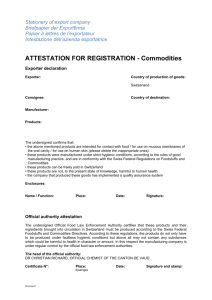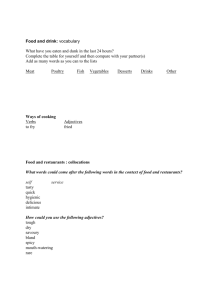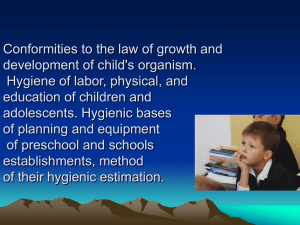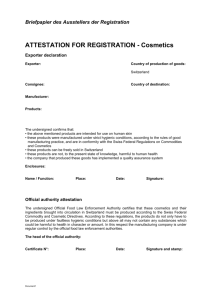communal hygiene
advertisement
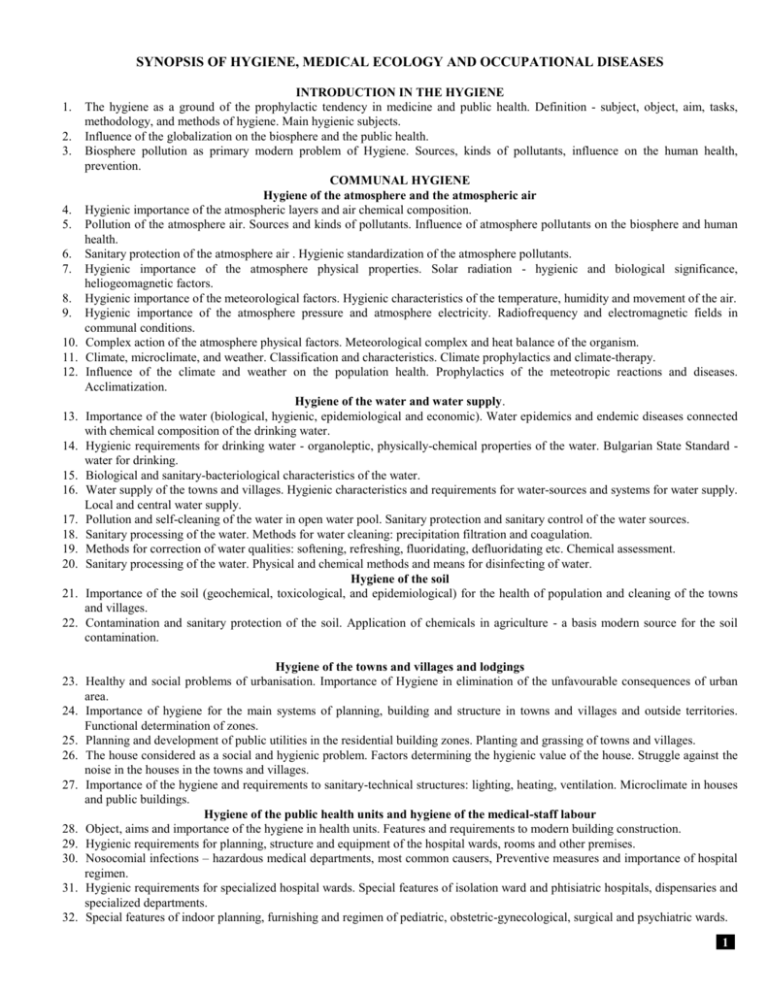
SYNOPSIS OF HYGIENE, MEDICAL ECOLOGY AND OCCUPATIONAL DISEASES 1. 2. 3. 4. 5. 6. 7. 8. 9. 10. 11. 12. 13. 14. 15. 16. 17. 18. 19. 20. 21. 22. INTRODUCTION IN THE HYGIENE The hygiene as a ground of the prophylactic tendency in medicine and public health. Definition - subject, object, aim, tasks, methodology, and methods of hygiene. Main hygienic subjects. Influence of the globalization on the biosphere and the public health. Biosphere pollution as primary modern problem of Hygiene. Sources, kinds of pollutants, influence on the human health, prevention. COMMUNAL HYGIENE Hygiene of the atmosphere and the atmospheric air Hygienic importance of the atmospheric layers and air chemical composition. Pollution of the atmosphere air. Sources and kinds of pollutants. Influence of atmosphere pollutants on the biosphere and human health. Sanitary protection of the atmosphere air . Hygienic standardization of the atmosphere pollutants. Hygienic importance of the atmosphere physical properties. Solar radiation - hygienic and biological significance, heliogeomagnetic factors. Hygienic importance of the meteorological factors. Hygienic characteristics of the temperature, humidity and movement of the air. Hygienic importance of the atmosphere pressure and atmosphere electricity. Radiofrequency and electromagnetic fields in communal conditions. Complex action of the atmosphere physical factors. Meteorological complex and heat balance of the organism. Climate, microclimate, and weather. Classification and characteristics. Climate prophylactics and climate-therapy. Influence of the climate and weather on the population health. Prophylactics of the meteotropic reactions and diseases. Acclimatization. Hygiene of the water and water supply. Importance of the water (biological, hygienic, epidemiological and economic). Water epidemics and endemic diseases connected with chemical composition of the drinking water. Hygienic requirements for drinking water - organoleptic, physically-chemical properties of the water. Bulgarian State Standard water for drinking. Biological and sanitary-bacteriological characteristics of the water. Water supply of the towns and villages. Hygienic characteristics and requirements for water-sources and systems for water supply. Local and central water supply. Pollution and self-cleaning of the water in open water pool. Sanitary protection and sanitary control of the water sources. Sanitary processing of the water. Methods for water cleaning: precipitation filtration and coagulation. Methods for correction of water qualities: softening, refreshing, fluoridating, defluoridating etc. Chemical assessment. Sanitary processing of the water. Physical and chemical methods and means for disinfecting of water. Hygiene of the soil Importance of the soil (geochemical, toxicological, and epidemiological) for the health of population and cleaning of the towns and villages. Contamination and sanitary protection of the soil. Application of chemicals in agriculture - a basis modern source for the soil contamination. Hygiene of the towns and villages and lodgings 23. Healthy and social problems of urbanisation. Importance of Hygiene in elimination of the unfavourable consequences of urban area. 24. Importance of hygiene for the main systems of planning, building and structure in towns and villages and outside territories. Functional determination of zones. 25. Planning and development of public utilities in the residential building zones. Planting and grassing of towns and villages. 26. The house considered as a social and hygienic problem. Factors determining the hygienic value of the house. Struggle against the noise in the houses in the towns and villages. 27. Importance of the hygiene and requirements to sanitary-technical structures: lighting, heating, ventilation. Microclimate in houses and public buildings. Hygiene of the public health units and hygiene of the medical-staff labour 28. Object, aims and importance of the hygiene in health units. Features and requirements to modern building construction. 29. Hygienic requirements for planning, structure and equipment of the hospital wards, rooms and other premises. 30. Nosocomial infections – hazardous medical departments, most common causers, Preventive measures and importance of hospital regimen. 31. Hygienic requirements for specialized hospital wards. Special features of isolation ward and phtisiatric hospitals, dispensaries and specialized departments. 32. Special features of indoor planning, furnishing and regimen of pediatric, obstetric-gynecological, surgical and psychiatric wards. 1 33. Hygienic requirements for emergency and treatment in an out-patients department.. 34. Economic sector of a hospital unit. Water supply, removal and making innoxious the hard and fluid waste products from hospitals. 35. Working environment and organization of medical staff. . Prophylactics of health and working capacity disturbances connected with professional work of medical workers. Personal hygiene 36. Object and tasks of personal hygiene. Hygienic grounding daily regimen. Hypokinesia, prevention of its late-effect. 37. Fitness, physical culture, and sports as elements of personal hygiene. 38. Hygiene of the skin, mouth cavity and teeth. Hygienic characteristics of washing and cosmetic preparations. Ionizing radiation hygiene 39. Hygienic problems in the use of radioactive substances and ionizing radiation in different fields of science, medicine and economic. 40. Principles of x-ray defense in ionizing radiation exposure. Norm for radiation safety. 41. General requirements for x-ray defense in work with open and closed sources of ionizing radiation. 42. X-ray defense of the staff and patients during work with roentgen appliances for diagnosing. NUTRITION HYGIENE 43. Main principles of the proper feeding. Regimen of feeding. 44. Differentiated physiological norms for feeding of persons in the different age and professional groups. 45. Investigation of population’s feeding. Importance, methods for control and evaluation of the real nutrition. 46. Proteins and fats - physiological role and importance, needs, hygienic norms, sources. 47. Carbohydrates, mineral substances, biomicroelements - physiological role and importance, needs, hygienic norms, sources. 48. Water and fatty-soluble vitamins - physiological needs, hygienic norms, sources. 49. Main principles of the protective professional feeding. Dietary feeding. 50. General hygienic requirements and hygienic evaluation of the foodstuffs. 51. Hygienic characteristics of foodstuffs of animal origin. Milk and dairy produce. 52. Hygienic characteristics of foodstuffs of animal origin. Meat and meat products. 53. Fish, poultry meat, eggs - nutritious and biological value, hygienic evaluation. 54. Foodstuffs of vegetable origin. Hygienic characteristics of cereals and goods produced from them. 55. Hygienic characteristics of the vegetable fats. 56. Hygienic characteristics fruits, vegetables, legumes, and kernel fruits. 57. Hygienic problems connected with cookery of the foodstuffs. Preservation of foodstuffs, methods for preservation, hygienic evaluation. 58. Food poisoning of microbial origin. Food toxic-infections - Salmonelosis etc. 59. Microbial food intoxications - Botulism, Staphylococcosis, Mycotoxicosis. 60. Non-microbial food poisoning caused by admixtures and additions in foods. 61. Non-microbial food poisoning by products of vegetable and animal origin - permanent, temporary or partly poisoning. Mushroom poisoning. 62. Principles of prophylactics of food poisoning. Tasks of the physician in case of arising of food poisoning. 63. Hygienic basis of the public catering. Hygienic requirements to the catering establishments. Control on the food preparation and the finished meals. OCCUPATIONAL HYGIENE 64. Occupational hygiene - objects, subject, aim and problems. Ergonomic and industrial aesthetics- essence and tasks. 65. Tasks of the work-shop physician for protection of health and working capacity of workers. 66. Conception for occupational noxiousness and occupational diseases. Classification of the occupational noxiousness and occupational diseases. 67. Labour and work. Social and biological character of labour. Classification and basis characteristic of the forms of labour. 68. Functional changes in the organism during physical work. 69. Functional changes in the organism during modern forms of labour. 70. Conception for working capacity. Fatigue and overfatigue - character and prevention. 71. Occupational noxiousness connected with incorrect organization of working processes. Prevention of injuries due to overstrain working posture, overfatigue. 72. Working environment – microclimate (indoor, outdoor ). Hygienic characteristics, influence on the health and working capacity of workers. Main measures for improvement of conditions for labour. 73. Atmosphere pressure as a factor of the working environment. Biological influence of the increased and decreased pressure. Prophylactics. 74. Infra-red and Ultra-violet radiation as a factor of the working environment. Prophylactics. 75. Radio-frequent electromagnetic fields as a factor of the working environment. Prophylactics of lesions. 76. Industrial noise - hygienic characteristics, influence on the organism. Occupational lesions from the noise influence. Prophylactics. 2 77. Infra- and ultrasound - sources, noxious influence, prophylactics of lesions. 78. Industrial vibrations. Sources, hygienic characteristics, influence on the organism, vibration disease. Prophylactics of lesions. 79. Concept for industrial poisons. Classification, sources, general characteristics. Importance of the way of penetration, metabolism, cumulation in the organism and separation of the industrial poisons for arising , diagnosis and prophylactics of occupational poisonings. 80. Industrial poisons. Toxic doses and concentration. Character of the isolated and combined action of industrial poisons. 81. Prevention of occupational poisonings. General principles and organization. 82. Dust as factor of working environment. Classification, main sources, pathogenic properties. Prophylactics of dust diseases. 83. Industrial traumatism (injury accidents). Different emergency cases. Prevention. Legislation. 84. Personal protective means - classification, hygienic requirements to them. 85. Hygienic requirements to the structure and uphold of industrial enterprises. Sanitary technical equipment, industrial lighting, heating and ventilation. 86. Safety working places – the role of occupational medicine experts. Legislation. Medico-biological and sanitary hygienic complex of activities. CHILDREN AND SCHOOL HYGIENE 87. Subject, aim and tasks of children and adolescent hygiene. 88. Content and methods of work of the physician in crèches and kindergartens. 89. Content and methods of work of the physician in primary and secondary schools. 90. Anatomical and physiological features of the organism of children and teenagers. 91. Problems of acceleration and biological maturity and their importance for the curative and prophylactic work in education units. 92. Hygienic ground of the education at the schools. Problems of the school physician. 93. Hygienic basis of daily regimen of the student. Prophylactics of the school fatigue. 94. Hygienic basis of the school and vocational training and consultation about their skills and capacity. 95. Hygienic basis of physical activity, sports and fitness of adolescents - importance, main principles, medical control. 96. Hygienic requirements for planning, structure and furnishing of crèches and kindergartens. 97. Hygienic requirements for school furnishing and school appliances. OCCUPATIONAL DISEASES 98. Occupational diseases - classification. Main principles of investigation, diagnosis, treatment and prevention. 99. Occupational health – organization, measures, legislation. Reporting for occupational pathology cases, medical documentation. 100. Occupational disease and professional accident - definition. Table of occupational diseases. 101. Pneumoconiosis - classification, etiology, pathogenesis. 102. Silicosis - clinical forms, x-ray findings and functional disturbances. 103. Diagnosis, differential diagnosis, complications, and concomitant diseases of the silicosis. Treatment and prophylactics. Expertise of working capacity of patients with silicosis. 104. Silicatosis - asbestosis, talcosis, kaolinosis. Clinic and diagnosis. Complications. 105. Occupational bronchitis - classification, etiology, pathogenesis and clinical picture. Etiologic diagnosis and criteria for occupational evaluation. Treatment prophylactics and expertise of working capacity of the occupational bronchitis. 106. Occupational bronchial asthma and bronchospastic syndrome. Etiology and pathogenesis. Criteria for etiologic diagnosis. Treatment and expertise of working capacity. Prevention. 107. Occupational poisoning by gases - chlorine, sulfur dioxide - clinical picture, treatment, expertise of working capacity. 108. Occupational poisoning by nitrogen peroxide and fluorine-hydrogen - aetiology, clinical picture, diagnosis, treatment and expertise of working capacity of acute poisonings. 109. Acute toxic injuries of respiratory organs. 110. Lead poisoning - contingent in danger, occupational risk, ways for arising of poisons, pathogenesis of the chronic lead poisoning. 111. Main clinical syndromes of lead intoxication. 112. Laboratory diagnosis, treatment, prophylactics and expertise of working capacity of the lead poisoning. 113. Benzine poisoning. 114. Chronic poisoning by mercury - occupational risk, pathogenesis and clinical picture of mercury poisoning. 115. Classification, treatment and expertise of working capacity of chronic poisoning by mercury. 116. Chronic poisoning by manganese. Occupational risk, clinical picture, diagnosis, treatment, and expertise of working capacity. 117. Chronic poisoning by cadmium. Occupational risk, clinical picture, classification, treatment, and expertise of working capacity. 118. Chronic poisoning by benzene. Occupational risk, pathogenesis, clinical picture, stage of disease, labour readjustment, treatment, and prophylactics. 119. Chronic poisoning by nitro-derivative of benzene. Occupational risk. Pathogenesis, clinical picture, diagnosis, treatment, and prophylactics. 120. Chronic poisoning by amino-derivative of benzene. Occupational risk. Clinical picture, diagnosis, treatment, and prophylactics. 121. Occupational poisonings by synthetic resins and plastics. Professions in danger, ways for arising, pathogenesis, clinical syndromes and treatment 3 122. 123. 124. 125. 126. 127. Poisoning by hydrogen sulfide - pathogenesis, clinical picture, treatment. Poisoning by carbon bi-sulfide - pathogenesis, clinical picture, treatment. Poisoning by ammonia - pathogenesis, clinical picture, treatment. Poisoning by carbon dioxide - professional risk, pathogenesis, clinical picture, diagnosis and prophylactics. Poisoning by pesticides - pathogenesis, clinical picture and emergency, treatment and prophylactics. Occupational injuries caused by incorrect organisation of working processes, compulsory posture of work, supertension and microtraumatisation of the particular organs and systems. 128. Diseases due to overstrain of the peripheral neural system - vegetative polyneuropathies - clinical picture, diagnosis, treatment and prophylactics. 129. Vibration disease caused by local vibration exposure - professions in danger, pathogenesis, clinical picture, treatment, expertise of working capacity and prophylactics. 130. Vibration disease caused by whole body vibration exposure - professions in danger, pathogenesis, clinical picture, treatment, expertise of working capacity and prophylactics. 131. Occupational damage of hearing - clinical picture, diagnostics, treatment, expertise of working capacity and prophylactics. 132. Infrasound, ultrasound - clinical picture, diagnostics, treatment, and prophylactics. 133. Occupational diseases caused by infra-red and ultra-violet radiation - clinical picture, diagnostics, treatment and prophylactics. 134. Occupational diseases caused by radio-frequent electromagnetic fields - pathogenesis, clinical picture, treatment, and prophylactics. 135. Occupational diseases caused by lasers - clinical picture, treatment and prophylactics. 1. 2. 3. 4. 5. 6. 7. 8. 9. 10. 11. 12. 13. 14. 15. 16. 17. 18. 19. 20. 21. 22. 23. 24. 25. 26. 27. 28. 29. 30. 31. 32. PRACTICAL EXAMINATION ON HYGIENE Methods for hygienic investigation and evaluation of main physical factors of the air - thermometry and hygrometry Methods for hygienic investigation and evaluation of main physical factors of the air - anemometry, barometry aktinometry. Methods for determination and evaluation of the complex influence of microclimatic factors. Physiological methods for evaluation of the microclimate action on the organism. Methods for investigation of atmosphere air pollution. Methods for taking of air specimens. Methods for determination of concentration of gas air pollutants: carbon oxide and carbon dioxide. Methods for determination of concentration of gas air pollutants: nitric oxide. Methods for determination of concentration of gas air pollutants: sulphur dioxide. Methods for investigation of dust quantity in the air. Determination of lead aerosols. Methods for investigation and sanitary control of water sources. Tasks of the preliminary and current control. Methods for taking of water specimens. Indexes for sanitary evaluation of the water. Methods for hygiene-laboratory analysis of drinking water - organoleptic and physical properties. Methods for hygiene-laboratory analysis of drinking water - determination of organic substance (oxidation), chlorides and sulphates. Methods for hygiene-laboratory analysis of drinking water - ammonia, nitrites, nitrate. Methods for hygiene-laboratory analysis of drinking water - microbiological indexes, oxidation. Methods for disinfecting and cleaning of water - chlorinating and coagulation. Sanitary investigation of house and public buildings. Methods for evaluation of sanitary-technical structures: lighting, heating, ventilation. Principles and requirements for sanitary investigation of public health units. Methods for food control. Classification of workers according to the energy consumption. Hygienic evaluation of menu-ration and food regimen in different age and professional groups. Sanitary-expertise of foods and foodstuffs - taking of specimens for analysis. Sanitary-expertise of foods and foodstuffs - sanitary expertise of milk. Sanitary-expertise of foods and foodstuffs - sanitary expertise of meat. Sanitary-expertise of foods and foodstuffs - sanitary expertise of baby food and tinned food. Principles and requirements of the preliminary and current sanitary control to the catering establishments. Psychophysiological methods for evaluation of the work, the degree and character of the fatigue. Indexes for evaluation of the cardiovascular and respiratory systems. Physiological methods for evaluation of the work, the degree and character of the fatigue. Investigation of the neural system and analyzers. Toxicological methods for evaluation of chemical hazards. Prophylactics of pesticide poisoning. Cholinestherase activity determination. Methods for hygienic evaluation of the noise. Methods for hygienic evaluation of the vibration. Measures for health protection of workers. Environmental sanitation. Measures for health protection of workers. Prevention of occupational diseases – medical and engineering measures. 4 33. Principles of x-ray defense in ionizing radiation exposure. General requirements for x-ray defense in work with open and closed sources of ionizing radiation. 34. Methods for evaluation of the physical development of the children – anthropometry, physiometry and somatoscopy. 35. Hygienic requirements for planning, structure and furnishing of crèches and kindergartens. 36. Hygienic requirements for school furnishing and school appliances. Medical University – Pleven Dep. of Hygiene, medical ecology, occupational diseases and disaster medicine Mariana Stoynovska, MD, PhD September 2011. 5
